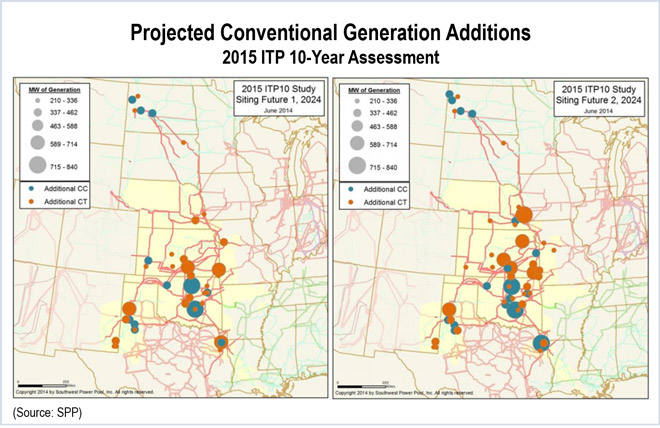By Rich Heidorn Jr.
TULSA, Okla. — SPP’s next 10-year transmission plan will consider three future scenarios to assess the potential impact of the Environmental Protection Agency’s Clean Power Plan, members agreed after a lengthy debate last week.
The Markets & Operations Policy Committee decided the 2017 Integrated Transmission Planning 10-Year Assessment will include one scenario assuming regional compliance with the EPA rule and one assuming state-by-state compliance. The third scenario will be a business-as-usual case that assumes the EPA rule is abandoned — due, for example, to a legal challenge or a change in leadership at EPA after the 2016 presidential election.
EPA plans to issue the final rule this summer. It is intended to reduce power generation CO2 emissions by 30% from 2005 levels.
SPP this month released a study estimating the RTO could comply with the rule through a regional approach that includes a $45/ton carbon adder and 7.8 GW of additional generation, most of it wind. The study estimated an annual cost of $2.9 billion in increased energy costs and capital spending for new gas and wind generation. It did not evaluate additional transmission that may be needed, an element ITP10 will seek to quantify. (See SPP: $45/ton Adder, Wind, Gas Meets EPA Carbon Rule.)
The Economic Studies Working Group had recommended use of three futures, including one that assumed increased load growth as a result of the elimination of the Clean Power Plan. MOPC members amended that to assume normal load growth — creating a business-as-usual scenario as a comparison with the regional and state-by-state compliance schemes.
Members first rejected a proposal to include a fourth future that included an “extreme” EPA final proposal. It won only 41% support. A second vote limiting the study to the regional and state compliance scenarios but allowing the working group to seek approval of a third future, also fell short at 57%.
Fundamental Questions
The debate over the study revealed fundamental questions over the RTO’s planning strategy.
“Once again we are doing the absolute minimum and not looking at the long-term future,” said Kristine Schmidt, vice president of regulated grid development for ITC Holdings.
Board of Directors Vice Chairman Harry Skilton said the 18-month timeline for completion of the study is too long. “This is unbelievably ridiculous that it takes this long,” he said.
Lanny Nickell, vice president for engineering, said the length of the study process reflects the incorporation of stakeholder input. “We have a very open and transparent stakeholder process,” he said. “That is very valuable, but it takes time.”
The debate continued during Wednesday’s meeting of the Strategic Planning Committee, as Skilton, Board Chairman Jim Eckelberger and member Phyllis Bernard called for changes.
Eckelberger said MOPC’s debate over whether it should spend $270,000 in planning staff salaries for a fourth future was shortsighted considering the at least $8 billion the RTO expects to spend on new transmission.
“We’ve got this all backwards,” he said. We’re “trying to put the right lines in the right place. We don’t want to misspend money. We don’t want to get it wrong. We want to have as much foresight as possible. We have not built the robust capability within SPP to get this right — and it’s one of our primary responsibilities.”
Steve Gaw, representing The Wind Alliance, said SPP needs information on a variety of generation sources it may call on under the EPA plan. “You can’t get there with two futures — or with three if one of them is a business-as-usual case.”
Skilton and Bernard also called for a broader range of scenarios.
“I’m not in favor of planning too far out, but I’m in favor of planning much more broadly — casting a really wide net,” she said. “But don’t necessarily try to project it too far forward because we don’t know what’s coming.”
Skilton said the RTO also should seek a shorter planning cycle — ideally six months instead of a two years.
“People have told me six months is impossible,” he acknowledged. “We may not get to six months but we won’t be at 24.”
Nickell said he would relay the board’s thoughts to the newly formed Transmission Planning Improvement Task Force, which has been charged with producing “more progressive, forward-thinking, regional planning processes that are more responsive” to the continued growth of SPP’s transmission system and markets in response to federal and state environmental regulations and reliability rules.
“If I could boil it down,” said Nickell, “you all said you want it bigger, better, quicker… more agile.”



